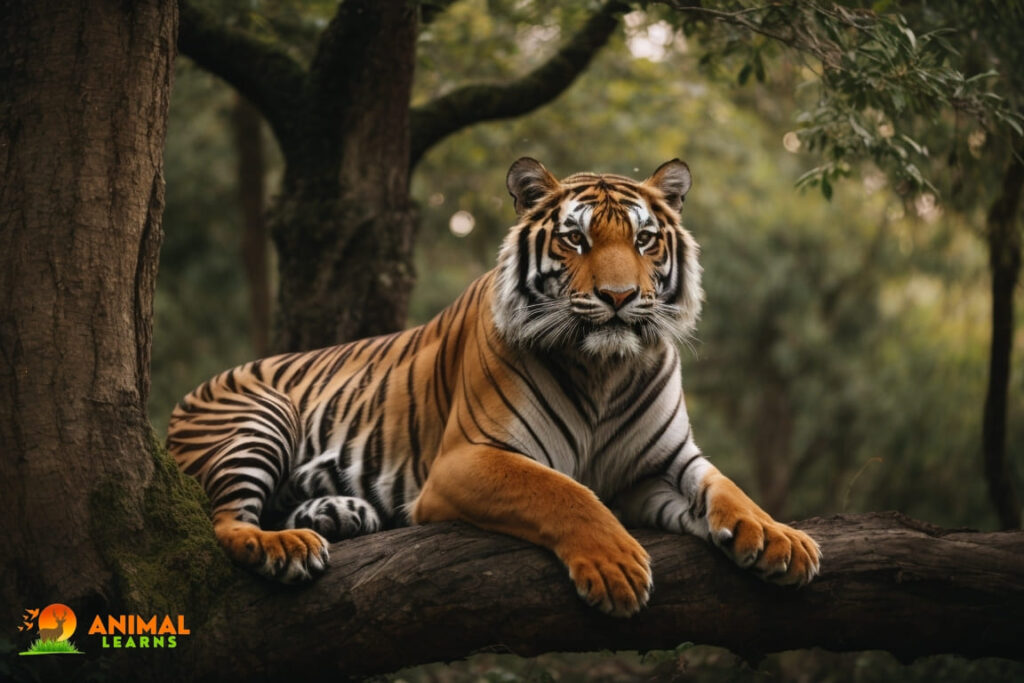Bengal Tiger: Diet, Habitat, Facts, and Population

| Category | Information |
| Scientific Name | Panthera tigris tigris |
| Length | Males: Up to 10 feet (including tail) |
| Females: Slightly smaller than males | |
| Weight | Males: 400 to 600 pounds |
| Females: 220 to 350 pounds | |
| Diet | Carnivorous, preying on deer, wild boar, |
| and other large hooved mammals | |
| Top Running Speed | and other large-hooved mammals |
| Lifespan | In the wild: 8 to 10 years |
| In captivity: Up to 20 years | |
| Location | Native to the Indian subcontinent, |
| including India, Bangladesh, Nepal, and Bhutan. | |
| Found in various habitats like dense forests, grasslands, and mangroves. | |
The Bengal tiger is one of the most endangered tiger subspecies on the Indian subcontinent and they can be found only in Bangladesh, Bhutan, India, and Nepal.
They are known for their orange coat adorned with bold black stripes, the tiger is the largest of the tiger subspecies and weighs much more than 500 pounds.
Apex carnivores are renowned for their prowess as predators. Within its vast and varied habitat, which includes dense forests, grasslands, and mangrove swamps, this animal prey mainly on deer, wild boar, and other ungulates. However, they face significant threats, primarily due to habitat loss, poaching, and conflict with humans.
The appearance
Contents

A Bengal tiger’s coat features an array of colors dominated by an orange hue and accentuated by dark, almost black stripes that run across its body. They are visually striking and iconic because of their vibrant orange background and bold black stripes, making them blend seamlessly into their natural environment, as well as standing out as symbols of strength and beauty in the animal kingdom.
Diet
A tiger is a carnivore, as are all tigers. They eat large, hooved mammals like chitals, gaurs, and sambars as their favorite meat. They will also eat barasingha, water buffalo, nilgai, serow, takin, wild boar, hog deer, Indian muntjacs, porcupines, hares, leopards, wolves, crocodiles, peafowl, and pangolffowl in a pinch.
In addition to attacking rhinoceros and elephants, these tigers are also suspected of coordinating attacks. Bengals attack livestock, so rural farmers must keep an eye out for them. In spite of the fact that history is full of stories about tigers eating people, it is a rare occurrence that occurs only when an animal has a disability and is unable to catch other food.
A tiger approaches from the back or side and immediately cuts the throat of its victim. The carcass is then dragged somewhere covered to eat by the tiger.
Characteristics of Bengal Cat

- One of the largest species of cats on earth is the tiger.
- Dark brown to black stripes on a yellow to light orange coat.
- The stripes on the tiger are similar to the fingerprints on a human. Each tiger has its own pattern of stripes.
- White belly and interior parts of limbs; tail is orange with black rings.
- This is a solitary animal that can swim well and climb well.
- Its canines measure 7.5 to 10 cm (3.0 to 3.9 in), making it the longest cat in the world.
- In Assam, Bengal, Bihar, and especially the former state of Rewa, there is a recessive mutant known as the white tiger.
- Among the rarest mutants in nature, the golden tiger has pale golden fur and red-brown stripes.
- In nature, mutations such as white and golden tigers are extremely rare.
- A male’s skull measures 351 mm (13.8 in) while a female’s measures 293 mm (11.5 in).
Life Cycle
They have a distinct life cycle, beginning with birth in the protective environment of a den and progressing through infancy, adolescence, and adulthood. Hunting skills and territorial instincts are acquired during maturation, a crucial phase.
The continuation of the species depends heavily on mating, which is an essential element of the life cycle. For this magnificent feline lineage to remain viable, successful reproduction is essential.
Habitat
Its habitat encompasses dense forests, grasslands, and mangrove swamps, just like the landscapes of the Indian subcontinent. Tigers have adapted well to a variety of habitats, which illustrates their resilience and adaptability.
As a result of widespread habitat loss, human settlements, and fragmentation of once-expansive territories, the species faces increasing threats.
Behavior and lifestyle
As apex predators, they live primarily on their own. As well as setting up and fiercely defending territories, they also scavenge prey and minimize conflicts.
They are adept at navigating diverse landscapes with intelligence and strategic precision during hunts by using stealth and ambush tactics. As part of ecological balance, vocalizations, and territorial markings contribute to communication.
In spite of their solitary nature, Bengal tigers engage in social interactions during the mating season, which is marked by courtship displays and temporary pair bonds. Habitat loss and human activity threaten the tigers’ ability to adapt to various environments.
Interesting Facts About Bengal Tiger

- They are symbols of strength and power in Indian culture.
- The distinctive roars of tigers can be heard for a long distance, as they communicate through vocalizations.
- Tigers attack from behind and prefer to attack people who are looking directly at them. Therefore, residents of jungle villages that share space with large cats wear face masks on the back of their heads.
- As a result of her damaged canine teeth, she was not able to catch normal prey in the late 1800s and early 1900s, killing 436 people around Nepal and Kumaun.
- Hunting at night is their primary activity, and they use their keen senses to locate prey in the dark.
- The tigers are thought to coordinate attacks on rhinoceros and elephants, as well as smaller prey like antelope.
- Approximately 12,000 to 15,000 years ago, they arrived in India.
Population
Due to anthropogenic pressures, these are in a precarious situation. In order to mitigate threats such as poaching, habitat destruction, and climate change, conservation efforts are paramount. For this magnificent species to survive, accurate population estimates and targeted conservation initiatives are essential.
Social systems
There is a strong sense of social system among tigers, unlike other big cat species, since each individual establishes a well-defined territory and fiercely defends it.
Species’ unique behavioral patterns require understanding their solitary tendencies so that conservation strategies can be devised to account for them. Social interactions are primarily limited to mating and raising offspring.
Predators

In spite of anti-poaching laws, it remains a huge problem to protect big game. Poaching and habitat destruction are the primary threats to these tigers, which lead to population fragmentation.
Unfortunately, a thriving black market for tigers’ skins and body parts encourages hunters to break the law. One kill can pay up to one year’s salary.
Further, the Indians’ 2006 Forest Rights Act has led to an increase in people moving into jungle areas and encroaching on tiger territory. Although the statute is beneficial to indigenous human communities, it is disastrous for cats on the subcontinent.
It appears that populations in these areas are increasing as a result of the establishment of tiger conservation units, also known as TCUs, by the Indian government.
There is still much more work that needs to be done to ensure the survival of these tigers in the wild, according to the International Union for Conservation of Nature (IUCN).
Mating
Despite mating all year round, Bangal tigers often give birth to babies between April and December. Bengals typically have litters of up to six during pregnancy. Babies tend to be born in sheltered areas such as tall grass, caves, and thick bush. Their gestation period is about 3.5 months.
Tigers develop a reproductive cycle that includes elaborate displays, vocalizations, scent marking, and temporary pair bonds during mating rituals and behaviors.
In order to ensure the viability of the next generation and contribute to the preservation of the species, the subsequent gestation period and cub-rearing phase are crucial.
In order to protect the future of this iconic feline species, it is imperative that comprehensive conservation efforts are undertaken, addressing both ecological and anthropogenic factors.
How Fast Do Tigers Run?

They are known for their impressive running speed and agility. They are capable of reaching speeds of up to 35 to 40 mph (56 to 64 kph) in short bursts, making them formidable predators. Although tigers are remarkable at running, unlike some other predators, they are not built for sustained long-distance running.
A combination of stealth and speed defines them as apex predators in their respective ecosystems, as they ambush and overwhelm their prey using their unique combination of strength and agility.
How Big are Bengal Tigers?
In the animal kingdom, tigers are among the largest subspecies of tigers. Their length can reach up to 10 feet, including the tail, with exceptional individuals exceeding these limits. Adult males typically weigh 400 to 600 pounds, but exceptional individuals can exceed this range.
Bengal tigers are slightly smaller than males, weighing between 220 and 350 pounds. This robust build, characterized by powerful limbs and a well-muscled body, underscores their power as apex predators.
Across the Indian subcontinent, these magnificent felines are known for their unique size and physical prowess.
Challenges faced

A number of threats confront the Bengal tiger, including habitat loss as a result of deforestation and human encroachment. Poaching, a result of illegal wildlife trade, further erodes its survival. As a result of climate change, prey availability is affected and threats are exacerbating.
FAQs
How many Bengal tigers are left in the wild?
The exact number is challenging to determine, but it is estimated that there are around 2000- 2,500 left in the wild.
What is the habitat of Bengal tigers?
These live in the Indian subcontinent, thriving in diverse environments like grasslands and mangrove swamps.
Bengal tiger lifespan in the wild?
In the wild, tigers typically live 18 to 25 years, varying based on factors like food availability and territory.
Main threats to Bengal tigers?
Threats include habitat loss, poaching for body parts, and conflicts with humans. Conservation efforts aim to address these issues.
How do Bengal tigers hunt?
Bangal tigers, carnivores, primarily hunt large ungulates like deer and wild boar, using strength and stealth to ambush prey with a powerful bite to the neck or throat.












